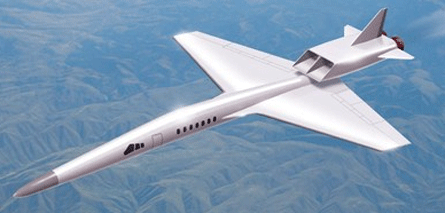European researchers have begun high-speed windtunnel testing of a supersonic business jet (SSBJ) design to investigate engine inlet size and nacelle integration drag penalties.
Inlet size is an important contributor to engine noise, with the larger inlets associated with higher bypass ratios enabling lower decibel levels on take-off and landing while generating greater drag in supersonic cruise.
Alenia's laminar-flow wing will be attached to the reference model |
Tests under the European Union's five-year, €26 million ($35 million) environmentally friendly high-speed aircraft (HiSAC) research project involve a reference configuration based on an SSBJ design from a Russian team lead by Sukhoi. The design team is one of three involved in HiSAC the other two are led by Alenia Aeronautics and Dassault.
The windtunnel models, being produced by a UK company, can have design features such as wing shape changed to provide parametric data. The models can have the two engines located either under the wing or at the base of the fin.
There is also a model without a vertical tail. They are being tested in French aerospace research agency ONERA's S2 windtunnel at Modane in the French Alps.
"Because of the drag associated with a high-bypass inlet the preferred solution is to have a small inlet and to introduce [atmospheric] air into the exhaust flow to reduce its global velocity and also to add a silencer," says Dassault's HiSAC co-ordinator Patrick Parnis.
An ONERA facility will also be used for supersonic engine acoustic tests. A small ground-test demonstrator engine is to be used for the acoustic work. To reduce noise levels the project's partners are also studying variable-geometry and mixer-ejector nozzles.
Windtunnel testing will also see the fitting of Alenia's supersonic laminar-flow wing design to the reference model. Parnis says the wing will be a major structural challenge because it has to be as thin as possible to maximise supersonic light-to-drag ratio.
Although one HiSAC design team is investigating a variable-geometry wing, he does not expect an SSBJ to have one because the wing thickness required to house the hinges negates the advantages.
As well as different wings, foreplanes are also of interest to researchers. Different canard layouts are being tested to find a better way to increase supersonic lift. Adding foreplanes would be an alternative to increasing wing size and the related drag penalty. Horizontal stabilisers are also being analysed.
The reference design would need synthetic vision for the crew because the long nose, shaped to reduce sonic boom, obscures the view during landing. Pilot vision was not a constraint for HiSAC design studies.
Related blogRelated stories
- Variable geometry lowers supersonic cruise altitude
- Talks ‘imminent’ as Alenia, Dassault and Boeing show interest in Sukhoi supersonic business jet
- Supersonic boom?
- On their Machs
Source: Flight International

















